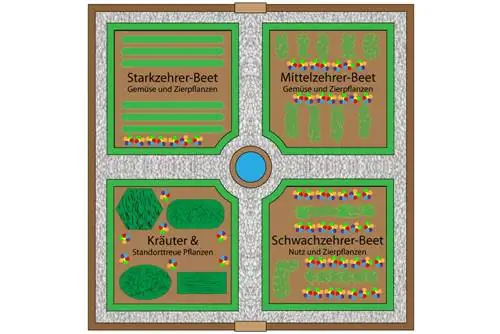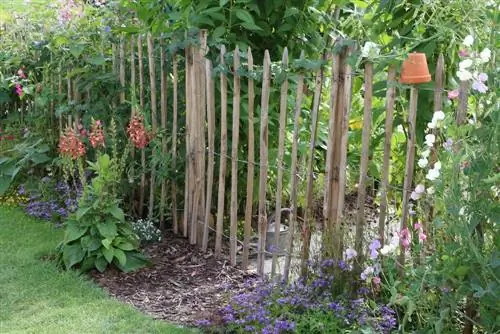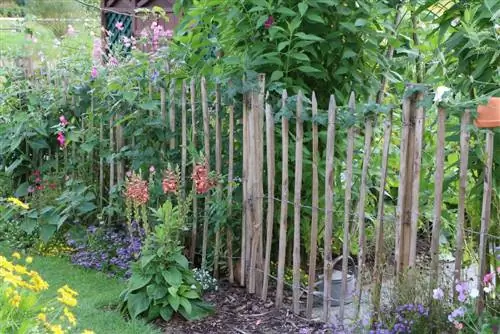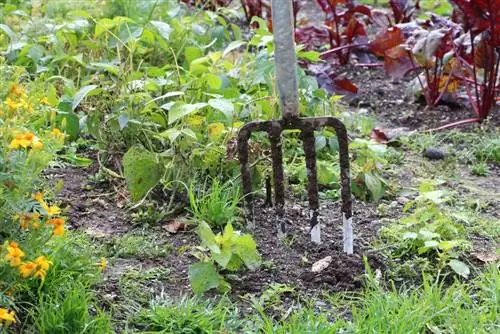- Author admin [email protected].
- Public 2023-12-17 03:39.
- Last modified 2025-06-01 06:48.
The cottage garden is surrounded by an aura of romantic opulence, paired with beguiling scents, seductive herbal aromas, and carefree enjoyment of vegetables and fruits. Here, magnificent ornamental and useful plants thrive side by side and present a picture of colorful wilderness, beyond standardized structures. What appears at first glance to be a floral commotion is actually the result of a well thought-out concept. At the same time, this nostalgic, original garden style offers you a variety of individual variations, tailored to your personal wishes and capacities. With lots of ideas and examples, these instructions show how the dream of your own farm garden becomes reality.
Planning work and floor plan
The lavish naturalness of a cottage garden requires detailed planning. This should be pushed forward during the winter until it is ready for a decision. In this way, work on the ground can begin as soon as the ground thaws in spring. Thanks to this caution, no valuable planting time is lost. All important aspects for skilful planning are examined in more detail below:
Location
The concentrated splendor of ornamental and useful plants can only unfold in the cottage garden if you choose a location with the following conditions:
- Sunny to semi-shady location
- Smaller, shady niches are no obstacle
- Warm and airy, without significant exposure to wind
- Nutritious, humus-rich soil
- Fresh and moist to moderately dry, without risk of waterlogging
The majority of typical plants for the cottage garden favor a slightly acidic to neutral pH value of around 6.5. If in doubt, check the soil acidity with a test set, which is available in every hardware store and garden center for less than 10 euros.
Tip:
If the soil conditions do not meet the ideal conditions, additives compensate for the deficits. Sandy soil is optimized with compost, leaf mold or bark humus. If the soil is solid, sand, fine grit or perlite provide more permeability.
Create a sketch for the floor plan

Regardless of the size of the area, please make a sketch that is as close to scale as possible. Note the different lighting conditions, which will make it easier to choose plants later. A shady niche does not necessarily have to be planted, but can be reserved for a compost heap. The following basic elements characterize the authentic cottage garden and are included in the planning drawing:
- The basic structure is formed by 4 equally sized, rectangular or square beds
- Access to the beds is via a crossroads
- Each bed has its own border
- A roundel marks the intersection of paths as the centerpiece
- A circumferential path allows access to each bed from outside
- An enclosure with 1 or 2 entrances acts as a border
- Between the surrounding path and the fence, a distance of 60-100 cm offers space for additional plants
Incorporate decorative elements into the sketch as desired, such as a bench, a fountain, rose arches over the entrances, statues or boulders as eye-catchers and other decorative components for a relaxed appearance. Naturalness is the key when selecting materials. Wood and stone in all variations underlines the claim of an original cottage garden. In contrast, materials of unnatural origin are taboo, such as plastic, aluminum or asph alt.
Tip:
So that the maintenance work in the finished farm garden can be carried out unhindered, a width of at least 60 cm, or the width of a wheelbarrow, should be planned for the paths. This minimum width also applies to the entrance(s).
Instructions for the construction work
As soon as the frost has come out of the ground in spring, work on the basic structure of the cottage garden can begin. Ideally, the area was dug up in the fall and old roots, stones and other contamination were removed. Incorporating compost or spreading green manure prepares the soil perfectly for later planting. If necessary, this work can be carried out before the actual construction work in February/March. How to create the perfect starting point for your cottage garden:
- Rake and weed the area thoroughly
- According to the planning drawing, mark the beds, paths, center and fence with stakes and cords
- Dig the soil 20 to 30 cm deep along the paths
- Filling with bark mulch, decorative gravel or chippings
- Alternatively, create a fine seedbed to sow lawns or lay turf as a path surface
If the budget allows it, natural stone slabs are ideal for paving the paths and the center. A natural and decorative look is created by later laying out individual natural stone slabs on lawn-covered paths as soon as the lawn has settled.
Fencing ideas
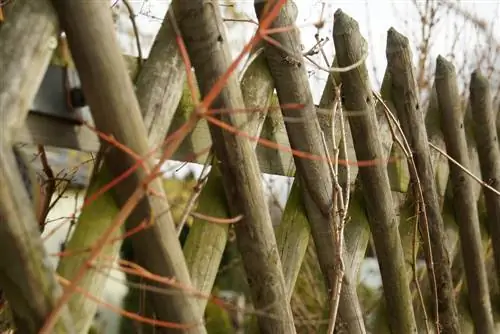
The selection of fencing is subject to various influences, such as the size of the area, the amount available or the harmonious coordination with the residential building. As a suggestion, we have put together traditional solutions for edging the site:
- Picket fence made of unglazed oak or chestnut wood, without crossbars, connected by galvanized wire
- Dry stone wall made of natural stones
- Wave fence made of natural willow
- Picket fence made of untreated wood
- Hunter's fence made of pine or spruce wood
An evergreen or flowering hedge creates an equally atmospheric color. This not only acts as a natural shield, but also offers insects and microorganisms a safe place to retreat. Alternatively, transform the wooden fence into a flowering bulwark by planting it with flowering fence-catchers such as dahlias (Dahlia), hollyhocks (Alcea), clematis (Clematis), marshmallow (Althaea cannabina) or cranesbill (Geranium).
Tips for bordering beds
The boxwood is on the decline as a classic for the shapely border of the bed, as the stubborn boxwood borer is spreading explosively. Nevertheless, you should not forego demarcating the individual beds in the cottage garden. This measure has more than just a visual purpose. Rather, the aim of mixed culture is to ensure that the plants do not overgrow each other or that invasive species do not spread uncontrollably. Instead of Buxus, you have a variety of easy-care options available, as the following selection proves:
- Delicate Lady's Mantle (Alchemilla epipsila)
- Blue cushion (Aubrieta)
- Cushion Phox (Phlox subulata or douglasii)
- Lavender (Lavender officinalis)
- Thyme (thymus)
- Bergilex (Ilex Crenata)
- Box-leaved barberry (Berberis buxifolia)
- Dwarf ligustrum (Ligustrum vulgare)
As an attractive alternative to floral bed borders, creative hobby gardeners use a mini version of the property fence. A harmonious look is created when the picket or hunter fence is repeated in small format as a bed border. Natural stone slabs placed upright, which can be found on the paths, also create a picturesque appearance that is in keeping with the basic ideas of the cottage garden.
Examples of center design
In the heart of the farm garden, the paths converge to the junction that attracts everyone's attention. To ensure that the center meets expectations as a visual highlight, there are a variety of creative design options available. Typically the core is round in shape. However, there is nothing wrong with giving it a rectangular or square shape. We have looked around Germany's cottage gardens and put together the following examples as inspiration for you:
- A rose roundel framed by low, evergreen Bergilex
- An obelisk covered with flowering vines
- A stone statue, planted with cushion perennials or floribunda roses
- A fountain with a mini pond
- A solitary fruit tree, elderberry bush or flowering bush
- A herbal spiral
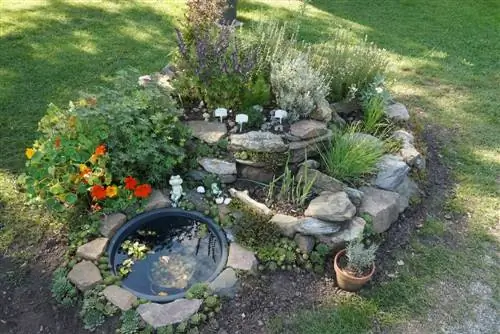
You are moving along the mystical paths of archaic cottage gardens when you choose a Sade tree (Juniperus sabina) as an eye-catcher. This type of juniper is part of the ancient garden culture, which our ancestors said was able to ward off evil spirits, illness and misfortune. Since this tree is poisonous in all parts, it is not on the shortlist for the family garden.
Suggestions for the planting plan
Planting naturally plays a key role in the newly created cottage garden. Based on a mixed culture according to the 4-field economy, the maintenance effort remains within a manageable range in order to achieve the hoped-for goal. In a mixed culture, plants are kept together that get along well. In concrete terms, this means that they have a positive influence on each other through root exudates, different use of water and nutrient reserves and rooting depths. In this way, optimal results can be achieved in terms of harvest yield and abundance of flowers in a very small space. The result is optimized by planting the beds alternately every year with heavy, medium and low consumption crops and ornamental plants. The fourth bed can be used either as a herb bed and orchard or offers enough space for plants that are loyal to their location.
Example of a self-sufficient cottage garden with a decorative touch
During its historical career, the cottage garden went through numerous modifications, always adapting to the spirit of the times. The modern home gardener has developed a penchant for a mix of organically grown crops and lavish flowers. The following example shows how it works:
Beet 1 - heavy feeder
The following crops are suitable for the heavy feeder bed in the cottage garden:
- Broccoli (Brassica oleracea)
- Potatoes (Solanum tuberosum)
- Cucumis (Cucumis sativus)
- Tomatoes (Solanum lycopersicum)
- Melons (Cucumis melo)
- Kohlrabi (Brassica oleracea var. gongylodes)
The vegetable and fruit plants are combined with floral beauties in order to meet the requirements of a lavish and colorful cottage garden:
- Dark spur (Consolida ajacis)
- Feather poppy (Macleaya cordata)
- Chrysanthemums (Chrysanthemum)
- Sunflowers (Helianthus)
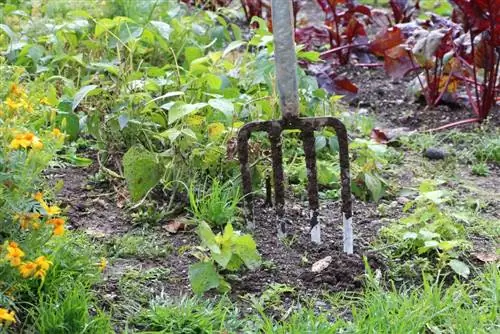
The weighting between useful and ornamental plants determines the status of the cottage garden as a predominantly self-sufficient or ornamental garden.
Beet 2 - Mittelzehrer
In the bed for medium-sized eaters, you are spoiled for choice, as a variety of delicious and magnificent garden plants come into focus here. The following selection would like to provide an insight into the broad spectrum:
- Eggplant (Solanum melongena)
- Chinese cabbage (Brassica rapa subsp. pekinensis)
- Beetroot (Beta vulgaris subsp. vulgaris var. conditiva)
- Endive (Cichorium endivia)
- Radicchio (Cichorium intybus var. foliosum)
- Common beans (Phaseolus vulgaris ssp. vulgaris var. vulgaris)
- Spinach (Spinacia oleracea)
The following ornamental plants like to be added to a neighborhood that is both profitable and decorative:
- Purple bells (Heuchera)
- Blue monkshood (Aconitum napellus)
- Bergenia (Bergenia cordifolia)
- Goldfelberich (Lysimachia vulgaris)
Annual summer flowers bring variety to the cottage garden from year to year. For example, if you sow marigolds (Calendula officinalis) in spring, they will radiate their colorful charm in the cottage garden well into autumn.
Tip:
In the specific composition of the plant neighbors, the height and width of the plant should be taken into account in addition to the nutrient and water requirements.
Beet 3 - weak feeder
The following species feel at home in the bed for vegetable and ornamental plants with low nutrient consumption:
- Lamb salad (Valerianella)
- Radish (Raphanus sativus var. sativus)
- Bush beans (Phaseolus vulgaris ssp.vulgaris var. nanus)
- Peas (Pisum sativum)
- Purslane (Portulaca oleracea)
This area of the cottage garden is rounded off by goose cress (Arabis caucasica), asters (Aster) or the frugal thrush (Armeria maritima). Small ornamental grasses, such as the native heart-grass (Briza media) or the noble golden-edged sedge (Carex dolichostachya), provide a look with natural abundance.
Bed 4 - options
The fourth bed in the dance is not limited to its function as a herb bed. If you have decided on a herb spiral as the center of the farm garden or only have a small need for herbs, this area is available to you as a gardening playground. The following list shows you what is useful at this point:
- Strawberries (Fragaria)
- Asparagus (Asparagus)
- Rhubarb (Rheus)
- Basil (Ocimum basilicum)
- Chives (Allium schoenoprasum)
- Parsley (Petroselinum crispum)
All kinds of berries tempt you here with tempting fruits and berries. Gooseberries, raspberries, cranberries or blackberries are great for snacking on. All of these location-faithful plants are also perfect for adding greenery to the strip between the surrounding path and the fence.
Example of a historic cottage garden
Do you want to create a rustic, nostalgic cottage garden that is free from the spirit of the times? Then take a look back at the historical beginnings. In the early Middle Ages, farmers became aware of the cleverly laid out monastery gardens with a large cloister, a fruit orchard and a vegetable and herb garden. In order to also bring in a rich harvest, the rural population copied the concept by combining all four gardens into the floor plan that is still in use today.
Thanks to Charlemagne's estate regulations and the writing of the St. Gallen monastery plan from the 9th century, we now know what the plantings were like at that time. A multitude of tasks had to be covered. This included a contribution to nutrition in the form of vegetables and fruit. Likewise, maintaining he alth with medicinal plants and warding off pests with poisonous and scented plants. Plants for starching or dyeing laundry were included. Last but not least, the farmers of the time valued beautiful flowers with recreational value and for decorating altars on church holidays. These plants generate your historic cottage garden:
Extract from Charlemagne's plant list from 812:
- Vegetables: cabbage, leek, carrots, broad beans, broad beans and lettuce
- Fruit: apples, plums, cherries, peaches, elderberries, gooseberries
- Herbs and spices: wild garlic, garlic, diptam, amaranth, sage
The ruler wanted roses, lilies and mallows for decoration in his farmers' gardens. A Sade tree should mark the center. The end of this list is the note that every gardener should plant houseleeks on their roof to ward off evil spirits and lightning strikes. It was only much later that potatoes, tomatoes and corn found their way into the farm garden, as these plants became known after the discovery of America.
Tips for an attractive decoration
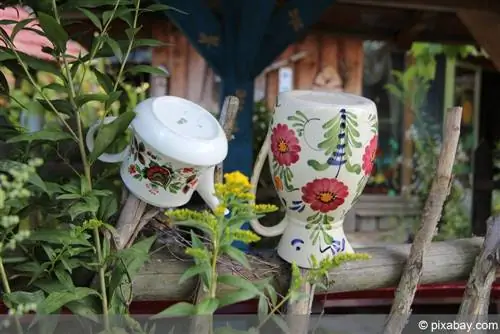
Small and large decorations tip the scales in the multi-faceted cottage garden. Regardless of whether you focus on utility or ornamental value, clever delicacies express the inimitable character of the rural country garden. The following suggestions would like to inspire your imagination:
- Place planted wicker baskets in the middle of the beds
- Place your own homemade scarecrow as an eye-catcher
- A zinc tub from the flea market with drainage holes and planted
- Convert a disused wheelbarrow into a planter
- Make a stone bench with a rose arch a cozy place to sit
When decorating, think about the garden's beneficial insects, kill two birds with one stone. Fill a rustic ceramic pot with wood shavings and place it on a fence post. Insects and microorganisms feel at home here and, as a thank you, hunt for pests.
Conclusion
For the dream of an idyllic farm garden to take shape, competent planning is important. Before you begin construction and planting work, the floor plan should be sketched and the ground prepared professionally. The simple basic structure consisting of a crossroads, 4 equally sized beds, a surrounding path and a fence sets the course. Only natural materials, such as wood and stone, are used to implement the ideas. The planting plan is based on the principle of mixed culture in conjunction with the 4-field economy. These instructions use two concrete examples to show how you can modify the concept of the cottage garden with a view to the spirit of the times. Alternatively, ignore the long history of the garden style's development and create a historic cottage garden like our ancestors cultivated according to Charlemagne's instructions. Picturesque decorative elements such as wicker baskets, scarecrows and zinc tubs creatively round off the nostalgic appearance.



